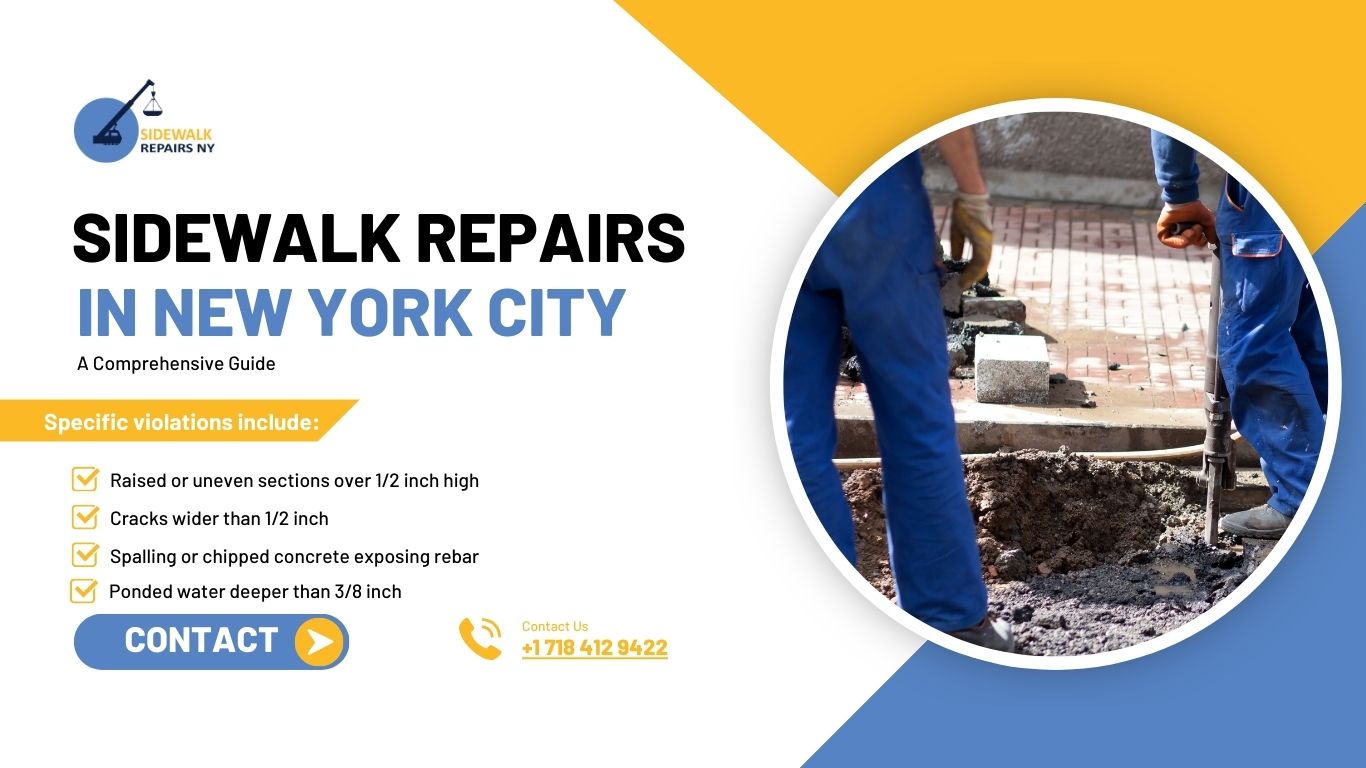Sidewalk Repairs in New York City: A Comprehensive Guide
New York City's sidewalks see heavy daily use from millions of residents and visitors. Over time, normal wear and tear can cause sidewalk damage and defects. Property owners are responsible for maintaining and repairing the sidewalks adjacent to their buildings. This article provides a comprehensive guide to sidewalk repairs in New York City.
Overview of Sidewalk Repairs
Sidewalk defects include cracked or uneven pavement, misaligned sections, and other trip hazards. Property owners must repair these issues to comply with city regulations and avoid injuries or lawsuits. Common repair methods include grinding raised edges, patching cracks, replacing broken sections, and relaying an entire sidewalk.
Professionals should handle sidewalk repairs to meet city standards. Most work requires a permit from the New York City Department of Transportation (DOT). You can contact the DOT at +1 718-412-9422. Property owners can be fined for unpermitted work or defects that must be addressed.
New York City Regulations
The DOT oversees sidewalk maintenance and repair requirements under the NYC Administrative Code Section 19-152. Property owners must keep sidewalks in good repair with no trip hazards or defects.
Specific violations include:
- Raised or uneven sections over 1/2 inch high
- Cracks wider than 1/2 inch
- Spalling or chipped concrete exposing rebar
- Ponded water deeper than 3/8 inch
Property owners must repair defects within 45 days of DOT inspection and notification. Failure to make timely repairs can result in fines of $75-$150 per violation plus related penalty fees. Unresolved violations become sidewalk liens attached to the property.
Hiring Contractors for Repairs
Property owners should hire licensed sidewalk contractors to handle complex repairs. Look for experienced companies that are insured, bonded, and have the proper DOT permits. Get estimates from at least 3 contractors.
Ask to see examples of their work and check reviews. Confirm they will pull permits, arrange sidewalk closures, and handle debris removal. Read the contract carefully, and wait to make the final payment until the work passes inspection.
Cost of Sidewalk Repairs
Sidewalk repair costs depend on the size of the area and the type of work needed. Here are the average costs for common repairs:
- Grinding down raised edges - $5-$15 per square foot
- Patching cracks and holes - $10-$30 per square foot
- Replacing broken sections - $15-$35 per square foot
- Full sidewalk replacement - $25-$60 per square foot
Factor in additional costs for permits, demolition, grading, and debris removal. Larger commercial properties or extensive repairs could cost over $100 per square foot.
DOT Permits and Inspections
Most sidewalk repairs require a DOT permit issued by the Office of Construction Mitigation and Coordination (OCMC). Apply for permits at least 12 days before starting work. You'll need to submit:
- Application form
- Site plans showing the work area
- Certificate of Liability insurance
- License and bond for contractors
The OCMC reviews applications and sets requirements like temporary sidewalk closures and pedestrian walkways to ensure public safety.
Repairs must meet DOT specifications on materials, surfaces, slopes, and drainage. Work must be inspected upon completion before returning the sidewalk to service.
Avoiding Sidewalk Liens
Unresolved sidewalk defects can result in liens against the property for the cost of repairs. The lien amount also includes fees, interest, and penalties.
To avoid liens:
- Inspect sidewalks regularly and make timely repairs
- Maintain records of repairs and compliance with notices
- Follow proper permitting procedures
- Pass all DOT inspections after repairs
If you receive a violation notice, immediately contact the DOT at +1 718-412-9422 to acknowledge receipt and schedule repairs. This shows a good faith effort to comply.
Conclusion
Regular sidewalk maintenance and repair is essential for property owners in New York City. Follow DOT regulations, hire experienced contractors, obtain permits, and pass inspections. This helps avoid injuries, fines, and costly sidewalk liens. With proper care, your sidewalks will provide safe access for all pedestrians.
Nofollow


Tomas Mandy
Neque porro quisquam est, qui dolorem ipsum quia dolor sit amet, consectetur, adipisci velit, sed quia non numquam eius